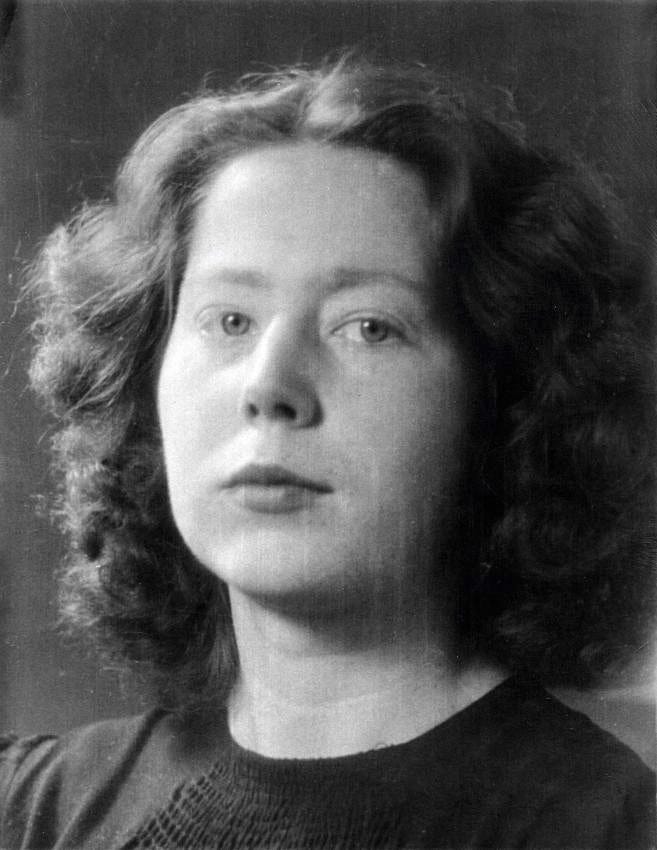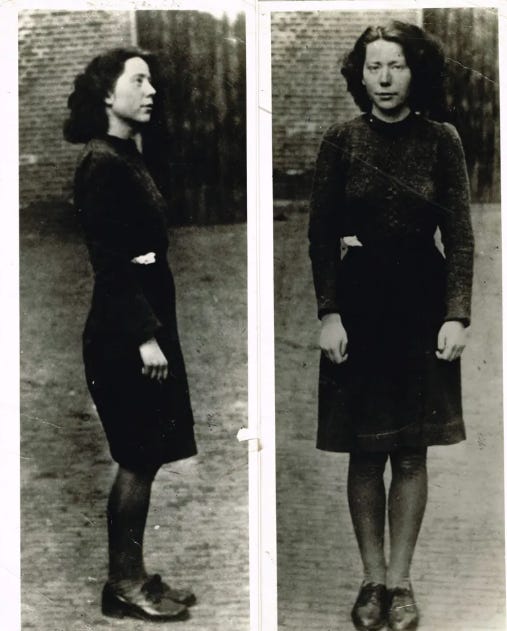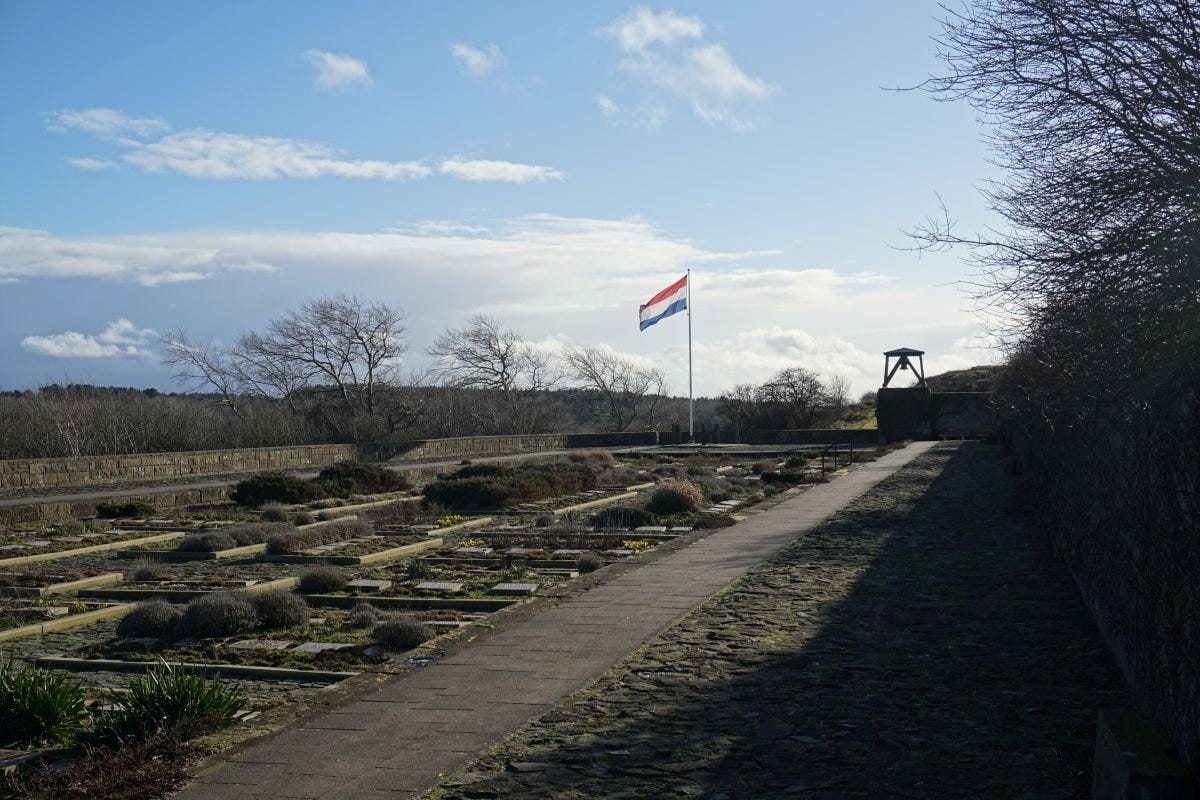The Story of Hannie Schaft and Truus & Freddie Oversteegen
"...just ordinary people who did what had to be done during extraordinary times."
When we hear "teenager" and "Nazis," our minds drift to Anne Frank, as it should. Her diary has been educating us on the German occupation of the Netherlands for decades. Anne Frank: The Diary of a Young Girl has been required reading in most school districts for the last 60 years, but she wasn't the only teenager in the Netherlands evading the occupying Nazi Regime.
During the same time that Anne and her family hoped and prayed to make it through the German Occupation inside the walls of her Father, Otto Frank's business – there was a resistance going on. The Raad van Verzet (Haarlem Council of Resistance), better known as the RVV, is the precise faction of resistance fighters I will be talking about. Why? The RVV had three participants: Truus Oversteegen, Freddie Oversteegen, and Hannie Schaft. Three young (Truss and Freddie were in their teens when they took up arms) women chose to fight the German Occupiers regardless of the danger or the possibility of death.
In recent months, I’ve seen a meme roaming around social media with an image of Freddie Oversteegen taken after she received the Mobilisation War Cross (Mobilisatie-Oorlogskruis) from the Dutch Prime Minister in 2014. The caption reads: Freddie Oversteegen died today in 2018. As a girl, she used to seduce SS men in Holland, take them into the woods, and shoot them. Below the image, someone added: “Seriously, how the f*ck do we have 5 thousand Batman movies and 7 million Spider-man reboots but zero movies about this chick?”
I couldn't answer the question because I had never heard of Freddie Oversteegen, which is how this journey began for me. I did what I like to do—research! This post is a "Cliffs Notes" version of what I learned.
Part One: The Oversteegen Sisters
Freddie Oversteegen was born on 6 September 1925 in Schoten, Netherlands. She was one of two daughters and the youngest.1 Her sister, Truus Oversteegen, was two years her senior, born 29 August 1923. Their parents, Jacob Wilhelm Oversteegen and Trijntje van der Molen, divorced when the girls were young, and their father left the picture, leaving their mother to raise them.
Together, Freddie, Truus, and their mother, Trijntje, lived on a barge and, later, in a small apartment, working hard to make ends meet. Regardless of how little they had, there is one thing Trijntje taught her two daughters – and that was to help. She considered herself a communist and used what she had – their tiny apartment – to help people safely pass through Haarlem. She also held meetings in their home where conversations of communism and socialism were spoken about widely.
The underlying theme was to help. If someone needed a bed, Trijntje provided one. If someone needed food, she fed them. Clothes? She found some. Through the network of their mother and the lives they lived, Truus and Freddie were taught to roll up their sleeves and get to work – helping.
When Germany made their way to the Netherlands – pushing the Franks into hiding as the Nazis began to round up Jewish Citizens – Trijntje's network began to change. The need to bring about change transformed into the need to protect the citizens of Haarlem and the Netherlands from the Nazis.
When Frans van der Wiel came calling round the van der Molen / Oversteegen home and asked Truus and Freddie if they would like to join the resistance, it didn’t take long for them to say yes.
When we are taught about the history of World War II, we are often greeted with images and stories of men. Strong men. Brave men. Men. Men. Men. That is how history is written – to highlight and uphold the images and belief that all things great and bold were brought to us via the male persuasion. This has been the story for decades. The elimination and removal of women from history is nothing new. Even during the occupation of the Netherlands, the Germans trained their attention on men.
Who would be a resistance fighter? The obvious choice was the strong, heroic Dutch. This bias made Truus and Freddie the perfect resistance fighters.
At the beginning of their time in the RVV, Truus was around sixteen, and Freddie was a mere 14. Who would suspect two teenage girls to be resistance fighters? Freddie was still round in her cheeks and looked all of 14 years old, if not a little younger. Together, they would climb aboard their bicycles and ride around Haarlem with guns in their bicycle satchel. They helped to hide Jewish families and children, and yes, they helped to "liquidate" Nazis.
Now, back to the meme. I think it's important to point out that Freddie was only 14 years old. There is no proof that she ever seduced Nazi soldiers.2 She did work as a lookout when her sister did, though; she also took part in assassinating Nazis – strategically – in public, from her bike, and by transporting weapons needed by the resistance.
Part Two: Hannie Schaft
Then there was Hannie Schaft. Born Jannetje Johanna Schaft in 1920 in Haarlem, Hannie's life started much differently than Truus and Freddie's. Her parents remained married through her entire life. While they were political, listening to the radio and reading the newspapers about the shift in politics around the world – when Truus and Freddie were working with their mother and listening to communists talk about equality – Hannie was getting a more traditional education.
By the time the Nazis moved into the Netherlands (and the royals of the Netherlands escaped to England), Hannie was at University. People there knew her as Johanna, or "Jo” for her friends. She dreamt of becoming a lawyer and working with the League of Nations3 to bring about change in the world—a dream she would never realize.
While Truus and Freddie Oversteegen joined the RVV at the beginning of the War, Hannie would arrive later. Hannie attempted to remain at University as long as she could, but once the Nazis mandated any student must sign a loyalty oath (that came with two years of service in Germany), Hannie saw no other choice but to leave school.
She refused to sign the oath and went back to Haarlem. Hannie returned home with her two best friends – Sonja Frenk and Philine Polak – two Jewish students she grew close to at the University of Amsterdam. The Schafts hid the two girls during the early years of the occupation; they also begged their daughter to keep quiet, remain home, and stay out of the sight of the Nazis.
But Hannie couldn't do this.
By the time Hannie Schaft joined the resistance, Truus and Freddie had been fighting for two years. And when Truus and Freddie first met Hannie, they weren't sure what to make of her. Here was this educated young woman who didn't speak like they did or dress how they dressed. It was said that Truus, even though Hannie was a plant, a spy sent by the Nazis to infiltrate the RVV.
It quickly became clear she wasn't and that Hannie—a name she adopted when she joined the resistance—was one of them: a resistance fighter.
Hannie Schaft quickly filled the role of a resistance fighter, so much so that she was seen as both fearless and maybe even reckless. Together with the Overnsteegen sisters, they distributed illegal newspapers, helped to smuggle Jewish children to safety, obtained forged documents, and liquidated of Nazis and Nazi sympathizers.
As the occupation intensified, so did their resistance activities. They sabotaged bridges and railroad tracks, helped downed Allied pilots escape, and ultimately engaged in direct armed resistance. Hannie Schaft became particularly notorious among the Germans, who knew her only as "the girl with the red hair."
She eventually dyed her distinctive red hair black to avoid detection, but her reputation had already spread.
The Girl with the Red Hair would become the title of a novel and, later, a film – both coming many decades after the end of World War II.
The SS and Nazi interest in the Girl with the Red Hair finally led to the discovery of her identity as Johanna Schaft. In the hope of persuading Hannie to turn herself in, the SS arrested her parents, Aafje Talea Schaft and Pieter Schaft, who they sent to Herzogenbusch concentration camp.
Truus once said that Hannie considered turning herself in, but in the end, she didn't. It was clear that if Hannie turned herself in, the Nazis would not let her parents go. So she fought on.
As the war began to turn, times in Haarlem were still hard. The faltering Nazi regime wasn't ready to give up their stronghold on the Netherlands. Plus, there was a shift in the Resistance movement. While the RVV had run the show for most of the year, later in the occupation, the Landelijke Knokploeg, or the LKP, joined forces with the RVV (and other resistance groups in and around the country.) The LKP was attached to the central government and, unlike the RVV, didn't see the importance of the role of Hannie, Truus, and Freddie.
Around this time, in March of 1945, Hannie Schaft was captured. There have been myriad theories about her capture over the years. Was she betrayed? Was it just luck?
How many times had Hannie ridden her bike around Haarlem and other parts of the Netherlands with bicycle satchels filled with guns for the resistance but never had been stopped. Then, just weeks before the liberation of the Netherlands, she is stopped and searched.
Hannie was taken into custody. After a further search, a gun was found on her person. There was only one reason to carry a weapon if you were not a Nazi officer — it meant you were a resistance fighter.
When higher-up SS Officers learned of her detainment, they took interest, determining the woman arrested was, in fact, the girl with the red hair. Over the following weeks, Hannie was brutally interrogated, yet she revealed nothing about her comrades.
When Truus and Freddie realized what had happened to their friend, they begged to go rescue her, but were denied. The resistance believed that the Allies were about to free the Netherlands, and therefore, soon Hannie would be free as well. Still, Truus couldn't live with this. She dawned a German Nurses Uniform and rode her bicycle to the prison where Hannie was being kept, only to learn she had been moved. Truus got on her bicycle once more and peddled through the night to the transfer prison – only to learn she was too late.
On April 17, 1945, just 18 days before the Netherlands was liberated, Hannie Schaft was led to the Overveen dunes near Bloemendaal. Her captor raised his gun and fired – but he missed. The next time he and his comrade raised their guns, they did not miss.4
Hannie was twenty-four.
Hannie was buried in a shallow grave in the dunes. Of the 422 bodies that would later be uncovered in the dunes, there was only one woman – Hannie Schaft.
On May 5, 1945, the German forces surrendered to the Canadian Allies in Wageningen, finally ending the war. While Hannie had not made it, the Oversteegen sisters survived.
It is easy to read texts about World War II and concentrate on all the male names we are presented with, yet the story of Hannie Schaft, Truus, and Freddie Oversteegen aren't rare. Women were on the beaches of Normandy on D-Day, they worked as couriers, intelligence officers, resistance fighters and more.
Freddie Oversteegen, who passed away in 2018 at age 92, summarized their motivation simply: "We were not heroes. We were just ordinary people who did what had to be done during extraordinary times." Four years before her passing, in 2014, she and her sister Truus finally received recognition for their services during World War II – sixty-nine years after the Netherlands had been liberated.
In the sixty-nine years, both of the Oversteegen sisters struggled with the psychological impact of their wartime actions. The term "Post Traumatic Stress Disorder" wasn’t coined until the 1980s, but that doesn't make it less read.
Truus channeled her experiences into art and writing – becoming a world-renowned artist.
While Freddie maintained a quieter profile, later in her life, she began to speak more about her experiences in the RVV, her missions with her sister, and her friendship with Hannie Schaft.
Hannie Schaft became a national symbol of resistance in the Netherlands. Her story inspired books, films, and monuments. The Dutch government posthumously awarded her the Resistance Memorial Cross in 1982, the same year a statue honoring Hannie Schaft was unveiled in Haarlem.
The statue was designed by Truss Menger-Oversteegen.
RESOURCES
Researching your ancestors who may have been resistance fighters can be trickey — especially if they were female. Still, “Tricky” isn’t “Impossible.” Here are some resources to help you explore the lives of these Dutch resistance fighters — and hints on how to research relatives who may have be resistance fighters outside of the Netherlands.
Books and Biographies:
Truus Oversteegen wrote about her experiences in the resistance. Under her married name of Truus Menger, Not Then. Not Now. Not Ever. is the story of her time in the RVV and her experiences during the German Occupation of the Netherlands.5 This book is currently out of print, BUT, it is listed in the WorldCat Database.6
Hannie Schaft's story has been documented in various biographies, such as The Girl with the Red Hair, which was later turned into a film by the same name.
Three Ordinary Girls: The Remarkable Story of Three Dutch Teenagers Who Became Spies, Saboteurs, Nazi Assassins—and WWII Heroes by Tim Brady. This is a newer book, released in 2021. It is an amazing read (or listen) and goes into a lot of detail.
Seducing and Killing Nazis by Sophie Poldermans - This is also another fantastic book to dive into. The author interviewed Freddie Oversteegen.
Books and biographies are a great way to begin to learn about what your ancestor lived through. Perhaps, like Hannie Schaft, they did not make it out of the War alive, by reading the accounts of those who did or the historians who have taken the time to research the period — you will learn more about the experiences your relatives had.
If you’re not sure if or what books exist to help you research the time period your ancestor lived in, or the war they fought in, ask a librarian at your local library. They will be able to help you get started.
Web Resources
- The National Hannie Schaft Foundation website offers resources and information on her life and legacy (available in Dutch but with assistance for international visitors). Also, remember that Google Translate can be added to your browser.
- Wikipedia pages on the Dutch Resistance and resistance members list key figures and events. While Wikipedia can offer mixed results, it’s still a great jumping off point. Remember to look at the bottom!! Any article you located on Wikipedia has a “Resource” section. This section will lead you to more information that will help you expand your resources. Books, articles, and other archives will be listed — it is the White Rabbit meant to lead you down the Rabbit Hole into research leads.
- JewishGen: This free online database offers extensive information on Jewish communities during the Holocaust, including timelines, frequently asked questions, and details about camps. It also provides research divisions focusing on specific regions and KehilaLinks that memorialize towns and villages where Jewish communities once thrived.
- The U.S. National Archives holds military records that can be useful for genealogical research. While not specific to resistance fighters, these records can provide valuable context about military service during World War II.
- Prisoner of War Records. This is how we know what we know about the last movements of Hannie Schaft’s life. By looking at the records kept about her time in prison and when she was executed — it was all written down. Some genealogy websites offer collections containing millions of diverse records from various sources, including papers from government offices. This link is for the National Archives — but there are many databases online and records in repositories around the world. Search the areas your ancestors lived to learn what is accessible to you.
- Military Medal and Award Records can reveal information about exceptional courage and fortitude shown by individuals during the war. They often include details such as service number, rank, regiment, and award type. Try searching your ancestors name AND the medal or award they may have been awards. [e.g. Brenda Smith AND Silver Star]
Also remember there are many institutions, libraries, and organizations who have dedicated time and resources to learn and protect the information of those who fought and resisted during the war.
Documentaries and Films
Look for documentaries or films like Soldaat van Oranje or others focusing on Dutch resistance stories. [note: Soldier of Orange was based on the book of the same name.]
- Resistance: They Fought Back about the Jewish Resistance in Europe.
- The Brave Fighters: Resistance Stories Near Hitler's Ukrainian Headquarters about the Resistance in Ukraine.
There are many more out there. Look online, visit sites like the National Archives, The Margaret Herrick Library, or the UCLA Film and Television Archives.
To learn more about about Genealogy by Aryn - head over to GenealogybyAryn.com, stop by and say hello on Bluesky - Instagram - Facebook - YouTube
Be sure to check out my Etsy Shop and stop by my Genealogy Shop.
For more information about my Genealogical Services visit GenealogyByAryn.com or email me at aryn.genealogy @ gmail.com. For more information on my Writing Coaching Services - visit ASYounglesAuthor.com
Truus and Freddie had a younger half-brother who was much younger than they were.
At least, from what I could find. The two occasions I learned of Nazis being seduced were by Truus and Hannie — both older than Freddie.
I originally wrote “United Nations” but the United Nations wasn’t founded until after World War II.
There are rumors that, after they missed, Hannie said, “I shoot better,” but there is no proof she said this.
Originally published in 1985 and later translated to English in 1998
You can also head over to ThriftBooks and put it on your watch list. And if you buy a copy, please send it to me. I only want to borrow it. Thank you.

















An extraordinary story, Aryn. You had me hooked from the reference to ordinary people in extraordinary times. A breathtaking story. Thank you for sharing it with new audiences.
What an incredible story.
I appreciated the thoughtful sources you added for others to research their family history. To Jewish Gen we can also add Yad Vashem, which has the goal of tracking down and naming every victim of the Shoah, but along the way has become a rich source of information on the world of pre-war Jewish Europe. I found out a lot about my husband's family and their hometowns that way (most rewarding was learning that the people in his grandfather's home town for the most part managed to escape east and later made it to Israel).
I was struck by the resemblance of Frans van der Wiel to Julian Barnes. Uncanny!